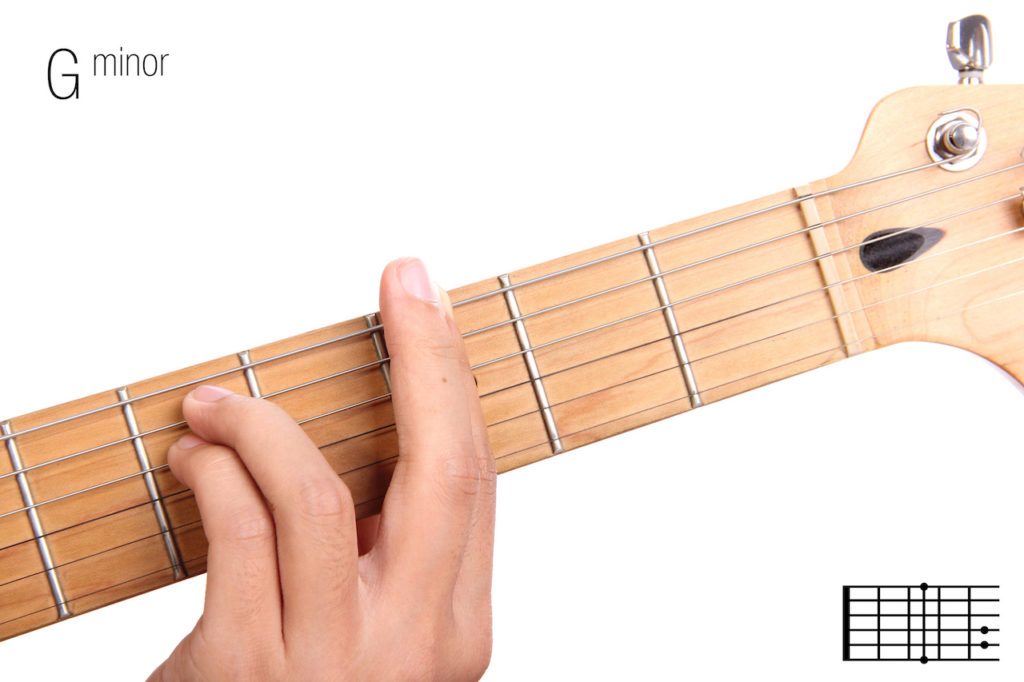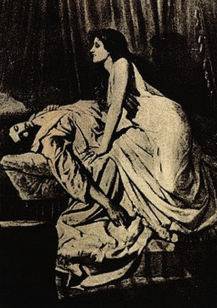The G Minor Chord on the Guitar: History, Chord Shapes & Popular Songs in the Key of G Minor
Author: Wanda Waterman

Table of Contents
G Minor History Lesson: The Winter of Our Discontent
G minor is never satisfied. Its level of anxiety, disappointment, ill humour, and resentment sometimes make it hard to take. G minor isn’t always fun to be around, but hey, who among us hasn’t on occasion turned into a joy-sucking emotional vampire? Thankfully, we guitarists have an outlet for such negative emotions, and when they’re over, we just change keys.

Mozart’s most poignant expressions of emotional pain were written in G minor, and it’s the main key for his numbered symphonies. Interestingly, during the classical period G minor symphonies nearly always employed four horns— two in G and two in Bb (G minor’s relative minor key).
The key of G minor is the relative minor of the key of Bb major. Why? Because both have the same key signature— four flats. A minor key is always three half-tones lower than its relative major; you can find the relative minor of any major key just by counting down three half-tones, which is exactly the same as counting down three frets on your guitar.

To dig deeper into minor scales and how they work, read this.
The G minor Chord Position on the Guitar: Just Like F Minor, Two Frets Up
!function(e,r,d){var t,c=e.getElementsByTagName(r)[0];e.getElementById(d)||(t=e.createElement(r),t.id=d,t.src=”https://uberchord-backend.firebaseapp.com/uberchord-embed-sdk.js”,c.parentNode.insertBefore(t,c))}(document,”script”,”uberchord-jssdk”);
!function(e,r,d){var t,c=e.getElementsByTagName(r)[0];e.getElementById(d)||(t=e.createElement(r),t.id=d,t.src=”https://uberchord-backend.firebaseapp.com/uberchord-embed-sdk.js”,c.parentNode.insertBefore(t,c))}(document,”script”,”uberchord-jssdk”);
As a great reminder of what we’ve been talking about regarding the “moveability” of some chord positions, this week’s chord position is exactly the same as last week’s F minor— just moved up two frets!
Like F minor, the key of G minor and the guitar chords required of it may be easy for some and hard for others, but putting our free Uberchord app in charge of your practice time can do wonders for your sound!
The basic G minor chord can be a bar chord using the forefinger across all strings at the third fret and two fingers holding down the fourth and fifth strings at the fifth fret. If full bar chords aren’t your thing yet, your forefinger can lie across the first three strings at the third fret and two fingers can hold down the fourth and fifth strings at the fifth fret. Both positions are moveable up the neck of the guitar (to form Ab minor, A minor, Bb minor, etc.), but with the second position you’ll have to be sure not to play the sixth string.
Theory and Practice: The Pattern of the G Minor Scale Explained
If you haven’t been following this series so far, it’ll help if you take a look at the differences between a major scale and a minor scale.
Unlike major keys, the tones in a minor key arrive in this sequence:
whole tone, half tone, whole tone, whole tone, half-tone, whole tone, whole tone
The second and the fifth places in the scale are each one half tone above their preceding notes, and all the other notes are whole tones above their preceding notes. All natural minor keys follow this pattern.
In the scale of G minor the notes are thus G, A, Bb, C, D, Eb, and F.
Below are two octaves of the G minor scale, with G at its root and another G, an octave higher, and yet another G at its highest point. Try sounding it out on your guitar according to the tablature below the scale.

You can play— and improvise!— more easily if you commit the notes on your guitar’s fretboard to memory. Here is a secret technique used by many pro guitarists around the world to learn the fretboard.
Optional Info: Harmonic and Melodic Minors
Recently we introduced you to harmonic minor keys, which are like the natural minors (the minor keys we’ve been studying so far) except that the seventh note is raised a half tone. In the key of G minor, this would raise the F to an F#.
We’ve also shown you melodic minor keys, which raise the sixth and seventh notes of the scale but only when ascending. When descending, the melodic minor scale is exactly the same as the natural minor scale.
Chords in the Key of G minor
It’s important to understand that not only are the sequences of tones different in minor keys as opposed to major keys, the chord patterns differ also, and the chords don’t follow the same pattern as the tones. In all minor keys (even the melodic, and harmonic) the chord sequence goes like this:
1st chord: minor
2nd chord: diminished
3rd chord: major
4th chord: minor
5th chord: minor
6th chord: major
7th chord: major
The G minor chord, which forms the root of the G minor scale, is made up of the notes G, Bb, and D— the first, third, and fifth notes of the key of G minor. On the guitar, using the full G minor chord shape shown in the diagram, these notes arrive in this order: G, D, G, Bb, D, G.
Why does this chord sound so different from the G major chord? The main difference is in the third string: The string that in the G major chord is held down at the fourth fret to create a B, in G minor is held down at the third fret to make a Bb. This is because G minor’s key signature dictates that B is flat, not natural as in G major. And that’s all it takes to turn a sweet little G major chord into a cranky G minor.
Because the basic G minor chord has no open strings, it’s not very resonant, but it is versatile. As we mentioned, you can play this same chord position all the way up the neck, making a minor chord wherever you might want one.
All this fancy talk depends on a knowledge of music theory. Studying music theory will make you a better musician and keep you from feeling stupid when other musicians bandy big words about. Our blog has a helpful set of music theory articles to get you going in the right direction.
Chord Progressions in the Key of G Minor
If you were to use each and every chord in the key of G minor, these would be the chords you’d use:
G minor, A diminished, Bb major, C minor, D minor, Eb major, and F major
The G, C, and D chords are minor because in the natural minor scale (unlike the major scale) the chords at the first, fourth, and fifth positions of the key are minor.
The A is a diminished chord because in the key of G minor it sits in second place— and in minor keys second place chords are diminished.
As in the major keys, the fifth chord— D minor in this case— can also be played as a seventh chord— in this case Dm7. Because it sits at fifth place, it has the honour of being the chord announcing the ending of the chord progression, and is generally followed by the root chord (G minor).
Adding the seventh note of the key of D minor (C) to the D minor chord, creating a Dm7, makes the chord sound like it’s moving the action ahead. Why? Because a chord that sounds slightly dissonant or “unresolved” sets up the ear to expect a sound that’s less dissonant. It’s one of those things that makes music what it is.
The seventh note in a scale is called a leading tone because of the way it leads us to the tonic, or root note of the scale, so it’s a great note to add to a fifth chord to “push the action forward.” If you want to better understand 7th chords and how to use them, check out this article on our blog. And if you want to know more about chord progressions, read the article series.
Chord Progressions in G Minor
To repeat, here are the chords in the key of G minor: G minor, A diminished, Bb major, C minor, D minor, Eb major, and F major. But simply playing these chords willy-nilly won’t make music; chords need to come in an order that’s pleasing to the ear.
!function(e,r,d){var t,c=e.getElementsByTagName(r)[0];e.getElementById(d)||(t=e.createElement(r),t.id=d,t.src=”https://uberchord-backend.firebaseapp.com/uberchord-embed-sdk.js”,c.parentNode.insertBefore(t,c))}(document,”script”,”uberchord-jssdk”);
“Paradise,” by Coldplay (verse and chorus)
Which is why we have chord progressions. Your practice sessions, after you’ve learned your chord shapes and how to play them, are made up of chord progressons. The songs you hear are made up of chord progressions. When you look up the chords to a song, you’re looking for that song’s chord progressions. The chord progressions should include the notes of the song’s melody and harmony as they move along, but they also have to sound good all by themselves.
By far the most common chord progression for folk, classical, jazz standards, country, and pop songs is loosely based on the following progression: I, IV, V, I (that is, on the first, fourth, and fifth chords in each key, major or minor).
In the key of G minor the chords in this progression are G minor, C minor, and D minor (or Dm7). Play the following progression, counting out four beats with every chord:
G minor— G minor—C minor— G minor.
G minor— G minor—C minor— G minor.
G minor—C minor— D minor (Dm7)—G minor.
Now that’s music.
Now try playing through the following progressions, listening for similar musical “messages.” Note which progressions sound finished and which ones leave you wanting more, especially if they end with Dm7. How long you play each chord is entirely your choice. If you feel really ambitious, string a few together and compose a new piece of music!
- G minor– D minor – Eb major – C minor
- G minor – Eb major — C minor – D minor
- G minor – D minor – Eb major – Bb major – C minor – G minor – C minor – D minor
- G minor – G minor – G minor – G minor – C minor – C minor – G minor – G minor – D minor – D minor – G minor – G minor
- A diminished – C minor – D minor
- G minor – C minor – D minor – C minor
- D minor – C minor – G minor
- Eb major – C minor – G minor – D minor
- Eb major – D minor – Eb major – D minor
Just A Few Great Songs in the Key of G minor
Before you start dismissing G minor as the “bad neighbor” of the minor keys, remind yourself that you too have moments of bitterness, resentment, discontent, and angst— and isn’t it great that there’s a key that can help you express all those negative emotions with the help of your trusty axe?
G minor can be misogynist’s taunt, like “Evil Ways” by Santana.
Deep Purple’s Smoke On The Water
It can be Sam Smith’s Like I Can
It can be a hymn to the sometimes harrowing pain of relationships, like Adele’s I Miss You
G minor is there for you in life’s dark places. Learn it well, because you never know when you might need the company of a depressed friend who gets what you’re going through.
And if you haven’t downloaded the Uberchord app yet, here are five great reasons why you should! By downloading the uberchord app, you can better absorb the knowledge on our free blog, like with this article. You can start with these articles on zoom pedal board order, porcelain guitar picks, and the gibson sg special marshall amp.
Sources:
music.stackexchange.com/questions/9798/the-differences-between-natural-harmonic-and-melodic-minors
jamieholroydguitar.com/10-must-know-jazz-standards
jazzguitarlessons.net/jazz-blues.html
pianoscales.org/songs-by-key.html
Rita Steblin (1996) A History of Key Characteristics in the Eighteenth and Early
Nineteenth Centuries, University of Rochester Press, p. 123
Emotions of the Musical Keys
The 10 Most Used Chord Progressions in Pop and Rock and Roll








“G minor can be misogynist’s taunt, like ‘Evil Ways’ by Santana.”
What?
I thought this was a well put together music theory site until it suddenly went insane.
I miss a time back before everything was a (pseudo-) social/political commentary created out of nothing but mental illness and then jammed into an inappropriate place to spread a delusional belief. Just the other day I read in Rolling Stone that Bob Dylan’s lyrics about past relationships constituted “assaultive language”.
Please fix your site so it provides great info, rather than commentary on bizarre personal inferrences from bland Santana songs.
B flat major and G minor have 2 flats, not four.